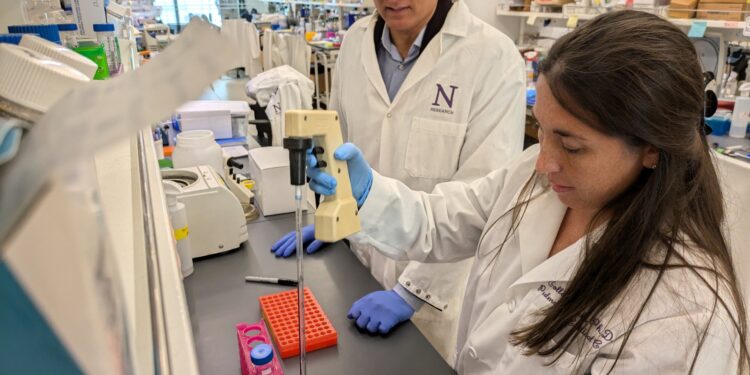Study authors Navdeep Chandel and Colleen Reczek in the lab at Northwestern University’s Feinberg School of Medicine. Credit: Northwestern University
Millions of people take metformin, a type 2 diabetes medication that lowers blood sugar. The “wonder drug” has also been shown to slow cancer growth, improve COVID outcomes and reduce inflammation. But until now, scientists have been unable to determine exactly how the drug works.
A new study from Northwestern Medicine has provided direct evidence in mice that the drug reversibly cuts off cells’ energy supply by interfering with mitochondria to lower glucose levels.
Specifically, metformin blocks a specific part of the cell’s energy-producing machinery called mitochondrial complex I. By doing so, the drug can target cells that may contribute to disease progression without causing significant cell damage. normal and healthy.
The study is published in the journal Scientific advances.
“This research allows us to better understand how metformin works,” said corresponding author Navdeep Chandel, David W. Cugell, MD, professor of medicine (pulmonology and critical care), Chan Zuckerberg Initiative investigator and professor in Biochemistry and Molecular Genetics at the Feinberg School of Medicine at Northwestern University. The study’s first author is Colleen Reczek, research assistant professor of medicine (pulmonary and critical care medicine) at Feinberg.
“This research significantly advances our understanding of metformin’s mechanism of action,” Chandel said. “While millions of people take metformin, understanding its exact mechanism remains a mystery. This study helps explain that metformin lowers blood sugar by interfering with mitochondria in cells.”
Metformin has been used as a treatment for diabetes for over 60 years. This relatively inexpensive drug, derived from compounds in the French lilac plant, is the first line of defense for many type 2 diabetes patients around the world, Chandel said. In the United States, some patients take it at the same time as other medications such as new diabetes drugs and weight loss drugs – semaglutides like Ozempic or Mounjaro.
Scientists have many theories about metformin’s effect on cells, but these theories are often based on research in separate fields and have provided only indirect evidence to support their hypotheses, Chandel said.
“Every year there’s a new mechanism, a new target for metformin, and in subsequent years people debate it and don’t come to a consensus,” Chandel said.
Because metformin requires a transporter to get inside cells, where mitochondria live, it only affects a handful of cell types, primarily in the intestine, liver, and kidneys. To test the role of mitochondrial complex I in glucose reduction, Reczek created mice genetically engineered to express a yeast enzyme (NDI1) that mimics mitochondrial complex I but is resistant to metformin inhibition.
-
The author of the first study, Colleen Reczek, liquefied metformin with pipettes. Credit: Northwestern University
-
First author Colleen Reczek in the laboratory at the Feinberg School of Medicine at Northwestern University. Credit: Northwestern University
They compared blood glucose levels in mice with and without metformin, and with or without the yeast NDI1 protein expressed. Glucose levels in control mice decreased upon metformin administration. In contrast, mice expressing NDI1 enhanced the reduction of glucose levels by metformin, indicating that metformin targets mitochondrial complex I to reduce glucose levels.
“Mice expressing NDI1 were not completely resistant to its hypoglycemic effects, suggesting that metformin may also target other pathways to some extent, but further research is needed,” Chandel said.
Previously, the Chandel group used NDI1 to demonstrate that the anticancer effects of metformin in cells that express the metformin transporter were also due to inhibition of mitochondrial complex I in cancer cells.
Additionally, one of the current study’s co-authors, Dr. Scott Budinger, chief of pulmonary and critical care in Feinberg’s Department of Medicine, has previously shown with Chandel that metformin can decrease pollution-induced inflammation in mice by interfering with mitochondrial complex I.
“We believe that metformin’s diverse effects on lowering glucose levels, decreasing inflammation and its potential anticancer effects could, in part, be explained by inhibition of mitochondrial complex I,” Chandel said. . “Eventually, others will need to corroborate our idea of mitochondrial complex I inhibition as a unifying mechanism to explain how metformin might improve human health.”
More information:
Colleen Reczek et al, Metformin targets mitochondrial complex I to lower blood sugar, Scientific advances (2024). DOI: 10.1126/sciadv.ads5466. www.science.org/doi/10.1126/sciadv.ads5466
Provided by Northwestern University
Quote: What is the secret sauce of metformin? New study shows how ‘wonder drug’ works in living animals (December 18, 2024) retrieved December 19, 2024 from
This document is subject to copyright. Except for fair use for private study or research purposes, no part may be reproduced without written permission. The content is provided for informational purposes only.



